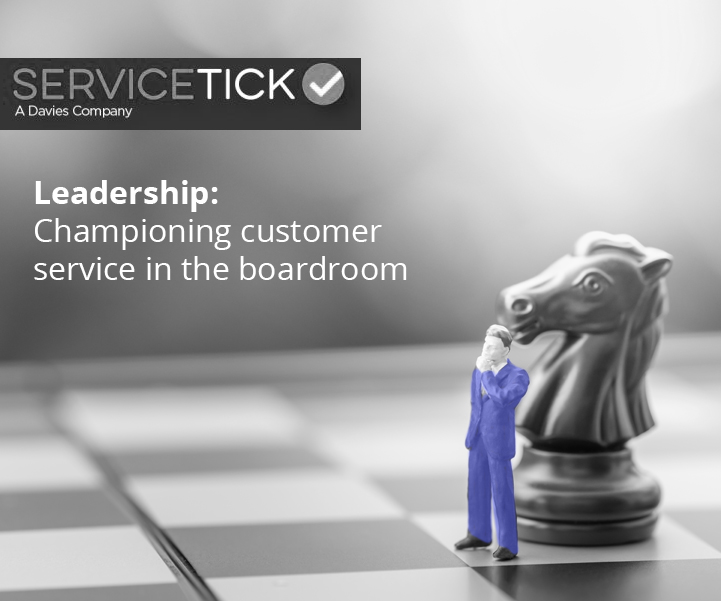National Customer service week – Day 4
10th October 2019

Leadership: Championing customer service in the boardroom
Each year Jeff Bezos writes a letter to Amazon’s customers, employees and shareholders. Part ‘thank you’ letter, part encouragement to shareholders it’s mainly a new chapter to the Jeff Bezos guide to running a successful business.
With every annual letter he republishes the very first letter he sent to shareholders in 1997, reinforcing his view of the need to obsess over customers. In his latest letter he returns to this theme: “Much of what we build at AWS is based on listening to customers. It’s critical to ask customers what they want, listen carefully to their answers, and figure out a plan to provide it thoughtfully and quickly (speed matters in business!). No business could thrive without that kind of customer obsession.”
Bezos is an example of an inspirational leader who recognises the fundamental need to champion customer service not just in the boardroom but across the whole organisation. He is not alone.
Sam Walton, founder of Wal-Mart, founded his business on the principle that: “There is only one boss. The customer. And he can fire everybody in the company from the chairman on down, simply by spending his money somewhere else.”
Jack Welch, CEO of GE, famously suggested: “On the face of it, shareholder value is the dumbest idea in the world. Shareholder value is a result, not a strategy…your main constituencies are your employees, your customers and your products.”
And our own Richard Branson said: “The way you treat your employees is the way they will treat your customers”.
These are people who were able to create a ‘cult-like culture’ – a common understanding of the behaviours required for success that all employees buy into. You can have the best blueprint for business in the world but, without effective leadership, it will only ever be a blueprint. The best leaders mix a number of skills and attributes but will demonstrate their ability to:
Walk the talk
Walking the talk means:
- getting out and about meeting staff. Not in some clinical, choreographed, photo-opportunistic way; but standing alongside them, experiencing their world, their concerns, their successes.
- reinforcing the core ideology of the company – this means a steady flow of communication in words that all employees can understand (not ghost written by a professional copywriter) and letting staff share in the highs and lows.
- reinforcing the core ideology of the company (2) – in the behaviours that the leader exhibits. It’s not hard to rumble a leader who only pays ‘lip-service’ to putting customer first. He is the CEO who has a personal parking space reserved for him by the front door (where the parking space for the disabled or elderly visitor should be!). Or the CEO who maintains the shareholder is more important than the customer (without customers there will be no shareholders). Strategies aligned with core purpose
Align strategies with a core purpose
The best leaders create strategies that are aligned with a core ideology:
- product strategies that reflect the core purpose – Steve Jobs made design the primary deciding factor for Apple strategy. Given a choice between cost and design, design came first. A choice between efficiency and design? Design won out. This simple mantra has shaped Apple success for the past three decades.
- recruitment strategies that reflect the core values – nearly half of all new First Direct starters are recommended by existing staff and over 95% of all roles are recruited internally.
- remuneration strategies that reflect doing the right thing by the customer – António Horta Osório, CEO of Lloyds bank is driving culture change by rewarding service rather than sales.
Motivate leaders throughout the organisation
In companies that deliver great customer experience, leaders can be found at every level of the organisation. Brands like Amazon and John Lewis – who regularly top the Institute of Customer Service’s (ICS) CSAT index top 50 – practice leadership ‘upwards and downwards’. They have brand guardians throughout the company who are prepared to challenge their managers if they identify a process or experience that is not true to the brand’s core ideology. They have employees who are invested in the brand and daily engaged in delivering the best possible experience.
Long-term leadership vs short term management
The average tenure of CEOs in the FTSE 100 is just over 5 years – barely long enough to implement long-lasting strategies. It’s telling that the CEOs who have made a mark in customer experience (the Jobs, Bransons and Dysons) tend to lead their companies for a lot longer. While the CEOs who haven’t get shown the door a lot quicker.
Peter Drucker, management guru and mentor of Jack Welch summed it up neatly: “Management is doing things right. Leadership is doing the right things”.
Related Articles
-
- Article
- Insurance Solutions
Insurance, with no questions asked
This article was first published by Insurance Times. With one-third of…
-
- Article
- Claims Solutions
- Insurance Solutions
National Customer service week – Day 5
Building brand reputation and trust by delivering on promises Each year…
-
- Interview
- Claims Solutions
- Insurance Solutions
CEO speaks as Davies Group revs up for overseas expansion
This article was written by Paul Lucas and first published in…
-
- Report
- Insurance Solutions
Our Group CEO Dan Saulter speaks to Insurance Business about our strategy for 2020
After working in a variety of positions as a chartered accountant,…



